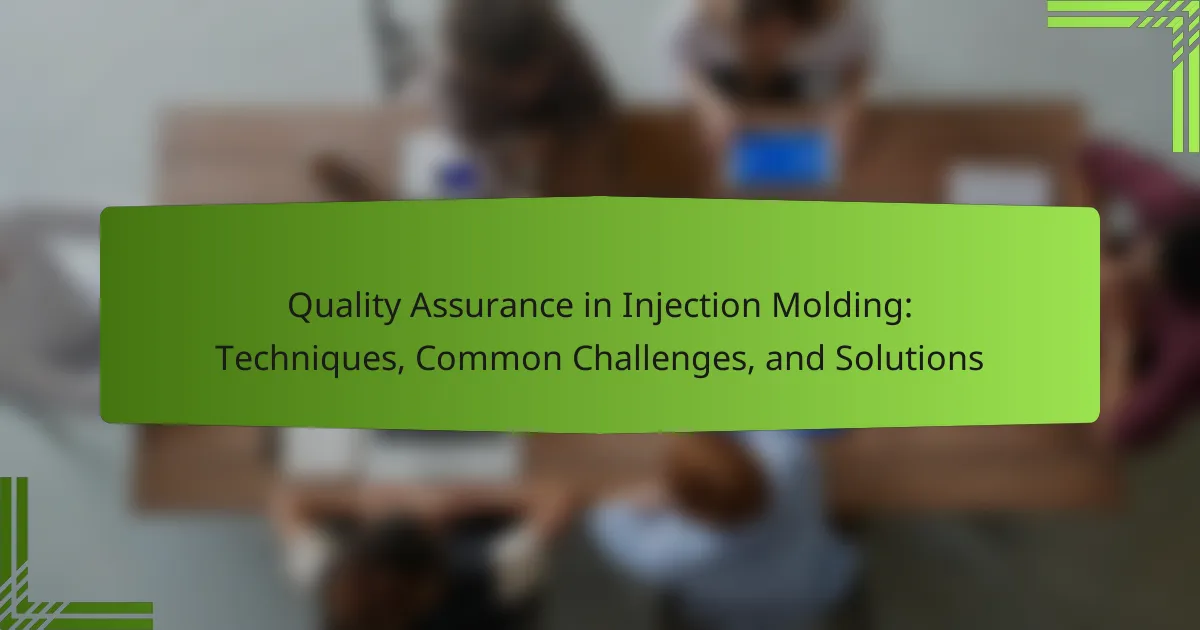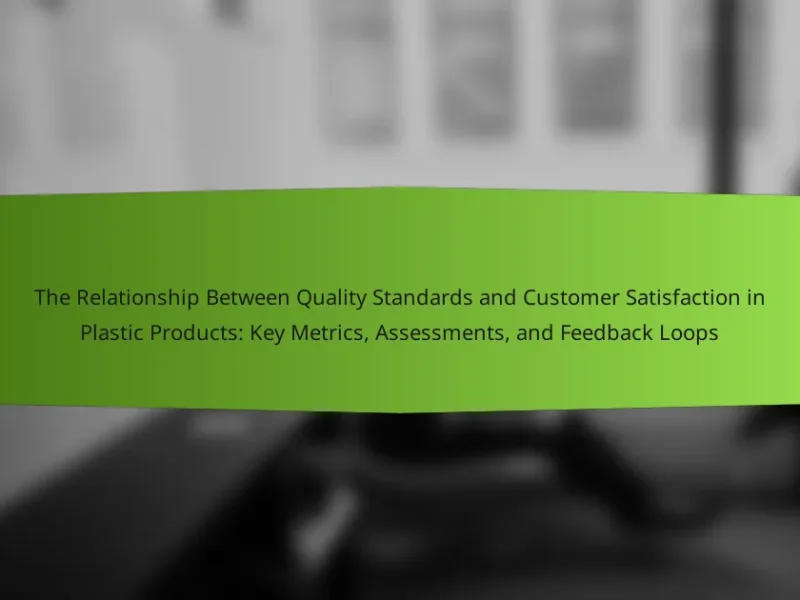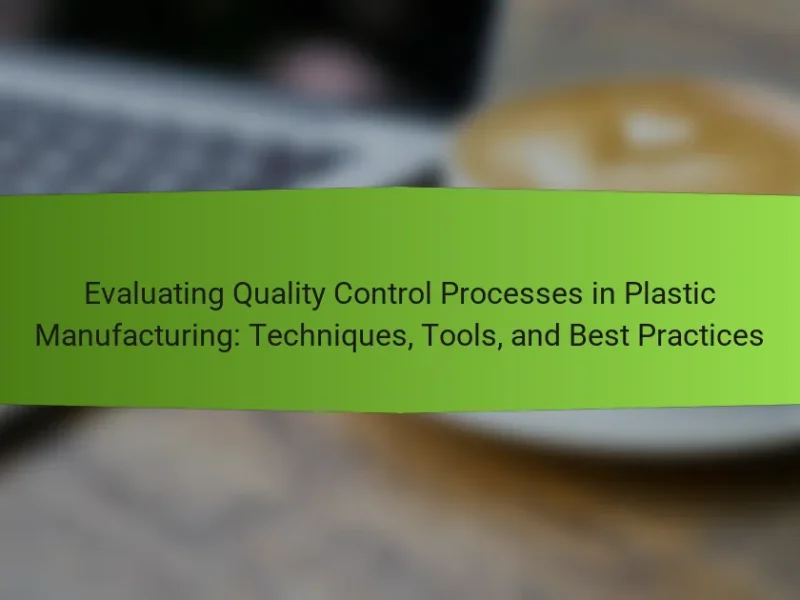Quality Assurance in Injection Molding is a systematic approach designed to ensure that products adhere to established quality standards throughout the manufacturing process. This article explores key techniques such as process monitoring, statistical process control (SPC), and visual inspections, which are essential for maintaining product quality and minimizing defects. It also addresses common challenges faced in quality assurance, including dimensional accuracy, surface defects, and material consistency, highlighting the importance of robust quality control measures. By implementing effective quality assurance strategies, manufacturers can enhance product reliability, reduce waste, and improve operational efficiency.

What is Quality Assurance in Injection Molding?
Quality Assurance in Injection Molding is a systematic process ensuring products meet specified quality standards. This process involves monitoring and controlling various aspects of the injection molding operation. Key areas include material selection, machine calibration, and process parameters. Quality assurance aims to minimize defects and ensure consistency in production. Techniques such as statistical process control and regular inspections are commonly used. These methods help identify deviations from quality standards early. By implementing quality assurance, manufacturers can enhance product reliability and customer satisfaction. Effective quality assurance can reduce waste and production costs, leading to improved operational efficiency.
How does Quality Assurance impact the injection molding process?
Quality Assurance (QA) significantly impacts the injection molding process by ensuring product consistency and quality. QA involves systematic monitoring and evaluation of the production process. It helps identify defects early, reducing waste and rework. Implementing QA protocols leads to improved cycle times and operational efficiency. Statistical Process Control (SPC) is often used in QA to track production metrics. This data-driven approach allows for real-time adjustments to maintain quality standards. Research indicates that companies with robust QA processes experience lower defect rates, enhancing customer satisfaction. Quality Assurance ultimately contributes to cost savings and improved market competitiveness in injection molding.
What are the key principles of Quality Assurance in injection molding?
The key principles of Quality Assurance in injection molding include process control, material quality, and product testing. Process control ensures that the injection molding parameters are consistently monitored and adjusted. This includes temperature, pressure, and cycle time. Material quality involves using high-grade raw materials that meet specified standards. This prevents defects and ensures uniformity in the final product. Product testing is essential for verifying that molded parts meet design specifications and functional requirements. This often includes dimensional checks and performance evaluations. Adhering to these principles minimizes defects and enhances product reliability in injection molding.
How does Quality Assurance ensure product consistency and reliability?
Quality Assurance ensures product consistency and reliability through systematic processes and standards. It involves defining quality criteria and implementing testing protocols. Regular inspections and audits are conducted to monitor compliance with these standards. Statistical process control techniques help identify variations in production. Training for personnel ensures adherence to quality practices. Documentation of procedures and results provides traceability. These measures collectively minimize defects and enhance product performance. Studies show that effective Quality Assurance can reduce production errors by up to 50%.
Why is Quality Assurance critical in the injection molding industry?
Quality Assurance is critical in the injection molding industry to ensure product consistency and reliability. It minimizes defects and enhances overall production efficiency. Effective Quality Assurance protocols help identify issues early in the manufacturing process. This reduces waste and lowers production costs. According to a study by the American Society for Quality, implementing Quality Assurance can decrease defect rates by up to 30%. Additionally, consistent quality fosters customer trust and satisfaction. In a competitive market, maintaining high standards is essential for business sustainability. Quality Assurance also ensures compliance with industry regulations and standards. This is vital for maintaining safety and performance in molded products.
What are the potential risks of neglecting Quality Assurance?
Neglecting Quality Assurance in injection molding can lead to significant risks. These risks include product defects, which can compromise functionality and safety. Poor quality can result in increased production costs due to rework and scrap. Customer dissatisfaction may arise from unreliable products, damaging brand reputation. Additionally, regulatory compliance issues can occur, leading to legal repercussions. Financial losses may ensue from warranty claims and recalls. Ultimately, neglecting Quality Assurance undermines overall operational efficiency and market competitiveness.
How does Quality Assurance influence customer satisfaction?
Quality Assurance directly influences customer satisfaction by ensuring product consistency and reliability. Effective Quality Assurance processes minimize defects and enhance product quality. This leads to higher customer trust and loyalty. According to a study by the American Society for Quality, 70% of customers are more likely to repurchase when they experience high-quality products. Additionally, Quality Assurance can reduce returns and complaints, further boosting customer satisfaction. Thus, a strong Quality Assurance framework is essential for maintaining high levels of customer satisfaction in injection molding.
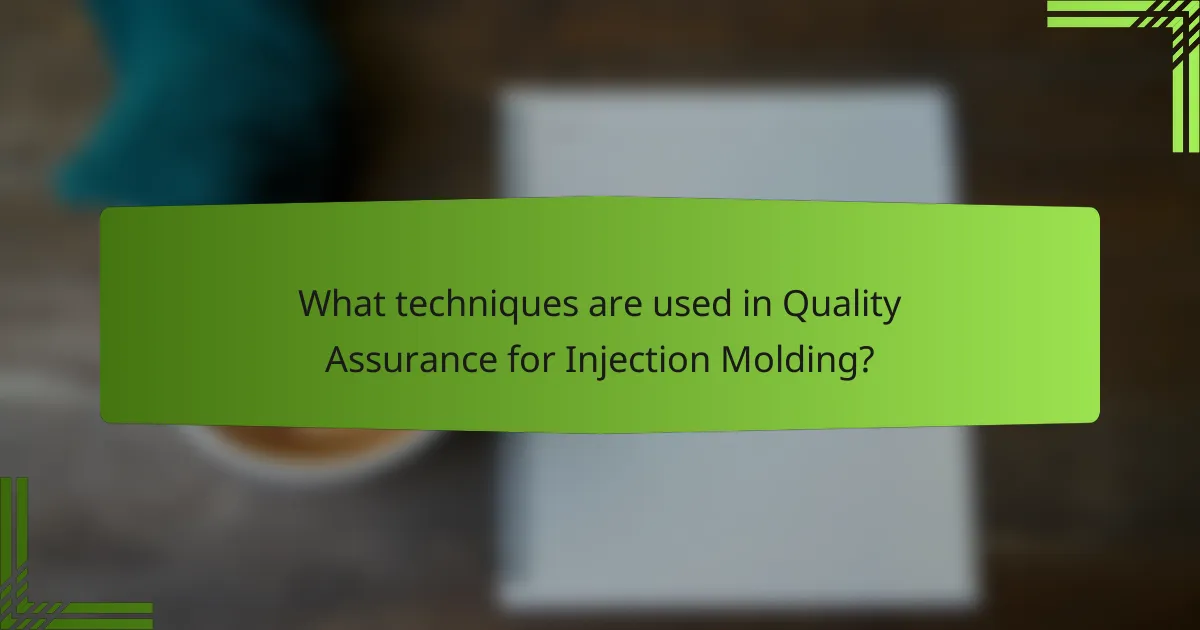
What techniques are used in Quality Assurance for Injection Molding?
Quality Assurance for Injection Molding employs several key techniques. These techniques include process monitoring, statistical process control (SPC), and visual inspections. Process monitoring ensures that the injection molding process remains within specified parameters. SPC utilizes statistical methods to analyze and control the manufacturing process. Visual inspections are conducted to identify surface defects and dimensional inaccuracies. Additionally, material testing is performed to verify the properties of the injected materials. These techniques collectively enhance product quality and reduce defects in injection molded components.
What are the most common Quality Assurance techniques in injection molding?
The most common Quality Assurance techniques in injection molding include visual inspection, measurement, and testing. Visual inspection involves checking for surface defects and inconsistencies in the molded parts. Measurement techniques assess dimensions and tolerances using tools like calipers and micrometers. Testing methods include tensile strength tests and impact resistance tests to ensure material performance. These techniques help identify defects early in the production process. Implementing these Quality Assurance methods can significantly reduce waste and improve product reliability.
How do statistical process control methods enhance Quality Assurance?
Statistical process control methods enhance Quality Assurance by providing data-driven insights into production processes. These methods utilize statistical techniques to monitor and control manufacturing operations. They identify variations in processes that may affect product quality. By analyzing data, organizations can detect trends and patterns that signal potential issues. This proactive approach helps in maintaining consistent product quality. Additionally, statistical process control facilitates continuous improvement initiatives. It allows teams to implement corrective actions based on real-time data. Research indicates that companies employing these methods experience reduced defects and increased efficiency. For example, a study by the American Society for Quality found that organizations using statistical process control reduced their defect rates by 50%.
What role does inspection play in the Quality Assurance process?
Inspection is a critical component of the Quality Assurance process. It ensures that products meet specific standards and requirements. Through inspection, defects can be identified early in production. This minimizes waste and reduces costs associated with rework. Inspection methods include visual checks, measurements, and testing. Each method provides valuable data on product quality. Regular inspections help maintain consistent quality levels. Ultimately, inspection supports customer satisfaction by ensuring reliable products.
How can automation improve Quality Assurance in injection molding?
Automation can improve Quality Assurance in injection molding by enhancing consistency and precision in the manufacturing process. Automated systems can monitor key parameters such as temperature, pressure, and cycle times in real-time. This continuous monitoring ensures that any deviations from set standards are detected immediately. Automated inspection systems can also identify defects in molded parts with high accuracy. Studies show that automation can reduce defect rates by up to 30%. Additionally, automation minimizes human error, which is a common source of quality issues. By standardizing processes, automation helps maintain uniformity across production runs. Overall, these improvements lead to higher product quality and increased customer satisfaction.
What technologies are utilized for automated quality checks?
Automated quality checks utilize technologies such as machine vision systems, artificial intelligence, and data analytics. Machine vision systems inspect products in real-time, identifying defects and ensuring compliance with specifications. Artificial intelligence algorithms analyze data patterns to predict potential quality issues. Data analytics tools aggregate information from various sources to enhance decision-making processes. These technologies improve efficiency and accuracy in quality assurance. Their implementation has been shown to reduce error rates significantly in manufacturing environments.
How does automation impact production efficiency and quality?
Automation significantly enhances production efficiency and quality in manufacturing processes. It reduces human error and increases consistency in product output. Automated systems can operate continuously, leading to higher production rates. According to a report by McKinsey, companies that implement automation can see productivity gains of 20-30%. Automation also allows for real-time monitoring of production quality. This ensures that defects are identified and corrected promptly. As a result, the overall quality of the final product improves. In injection molding, automation can streamline processes like material handling and part inspection, further enhancing efficiency and quality.
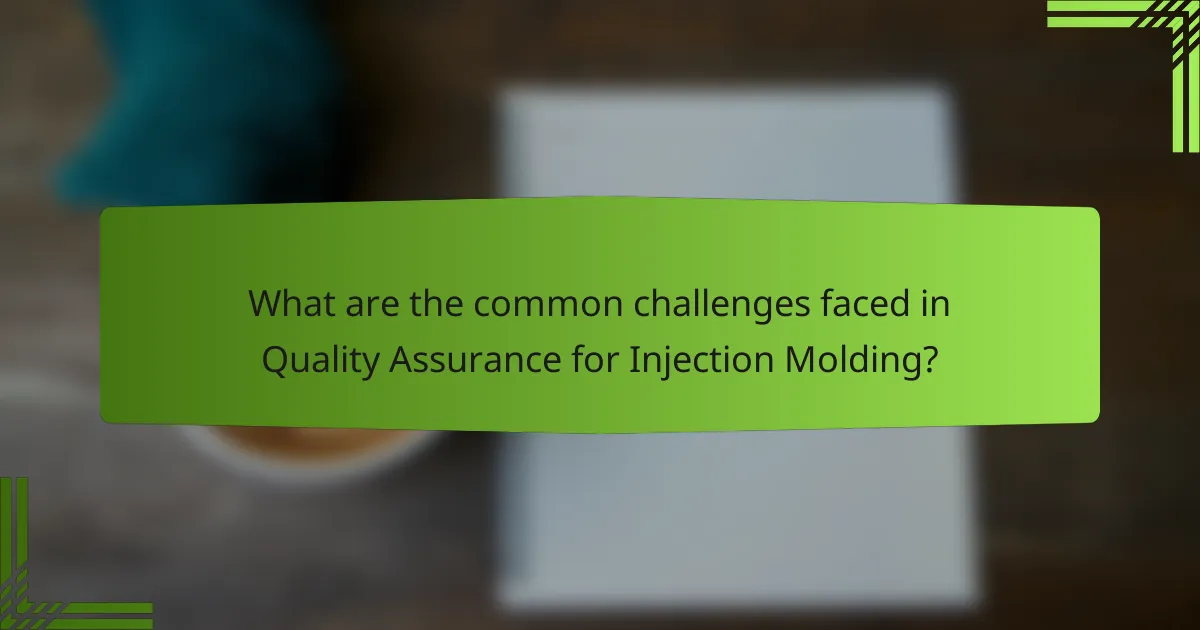
What are the common challenges faced in Quality Assurance for Injection Molding?
Common challenges in Quality Assurance for Injection Molding include dimensional accuracy, surface defects, and material consistency. Dimensional accuracy is critical as deviations can lead to part failure. Surface defects such as sink marks or blemishes can affect aesthetic and functional properties. Material consistency is essential to ensure uniformity in production, as variations can lead to inconsistencies in quality. Additionally, process stability is a challenge, as fluctuations in temperature or pressure can impact the final product. Another challenge is the inspection process, which can be time-consuming and requires precise measurement tools. These challenges necessitate robust quality control measures to ensure optimal production outcomes.
What specific challenges arise during the Quality Assurance process?
Quality Assurance in injection molding faces several specific challenges. One major challenge is variability in raw materials. Different batches of materials can lead to inconsistencies in product quality. Another challenge is the complexity of the molding process itself. Factors like temperature, pressure, and cooling rates must be precisely controlled. Equipment calibration is also critical. Incorrectly calibrated machines can produce defective parts.
Additionally, human error can impact Quality Assurance. Operators may misinterpret data or fail to follow protocols. Time constraints often pressure teams to rush, increasing the likelihood of mistakes. Finally, documentation and traceability can be challenging. Maintaining accurate records is essential for identifying issues and ensuring compliance. These challenges can significantly affect the overall quality and reliability of injection molded products.
How do material variations affect quality outcomes?
Material variations significantly impact quality outcomes in injection molding. Different materials possess distinct properties such as viscosity, thermal stability, and tensile strength. These variations can lead to differences in flow behavior during the molding process. For instance, a material with high viscosity may not fill the mold uniformly, resulting in defects. Additionally, variations in material composition can affect the final product’s mechanical properties. A study by Plastics Technology indicates that even slight changes in polymer blends can lead to significant variations in strength and flexibility. Quality outcomes are directly linked to the consistency of material properties used in production.
What issues can arise from machine calibration and maintenance?
Issues that can arise from machine calibration and maintenance include inaccurate measurements, equipment malfunction, and increased production costs. Inaccurate measurements can lead to defective products. Equipment malfunction may result in unexpected downtime. Increased production costs can occur due to inefficient operations. Additionally, improper calibration can cause safety hazards. Regular maintenance is essential to mitigate these risks. Failure to maintain machines can lead to wear and tear, affecting performance. Historical data shows that companies experience significant losses due to calibration errors.
How can companies overcome these Quality Assurance challenges?
Companies can overcome Quality Assurance challenges by implementing robust testing protocols. Regular inspections during the injection molding process can identify defects early. Utilizing advanced technologies like automated inspection systems enhances accuracy. Training staff on quality standards improves adherence to protocols. Establishing clear communication channels among teams fosters collaboration. Conducting root cause analysis for defects leads to effective solutions. Continuous improvement processes, such as Six Sigma, can optimize quality control. These strategies collectively minimize errors and enhance product reliability.
What best practices can be implemented to improve Quality Assurance?
Implementing best practices for Quality Assurance in injection molding includes establishing clear quality standards. These standards should be defined at the beginning of the production process. Regular training for staff on quality control measures is essential. This ensures that all team members are aware of the standards and procedures.
Conducting routine inspections of materials and finished products is crucial. This helps identify defects early in the process. Utilizing statistical process control (SPC) can also enhance quality monitoring. SPC allows for real-time data analysis to detect variations in the production process.
Incorporating feedback loops from production to design can improve overall quality. This practice ensures that any issues are addressed promptly. Additionally, maintaining open communication among all departments fosters a culture of quality.
Documenting all quality assurance processes and outcomes is vital for continuous improvement. This documentation provides a reference for future production runs and helps in identifying trends. Implementing these best practices can lead to more consistent quality and reduced defects in injection molding.
How can training and development enhance Quality Assurance efforts?
Training and development enhance Quality Assurance efforts by improving employee skills and knowledge. Enhanced skills lead to better understanding of quality standards and procedures. Employees trained in specific quality techniques can identify defects more effectively. This proactive approach reduces errors in production. Development programs can also foster a culture of continuous improvement. Engaged employees are more likely to contribute to quality initiatives. Research shows that companies investing in training see a 24% increase in productivity. Improved productivity directly correlates with enhanced quality outcomes.
What are practical tips for effective Quality Assurance in Injection Molding?
Implementing effective Quality Assurance in Injection Molding involves several practical tips. First, establish clear specifications for the molded parts. This ensures that everyone understands the quality standards required. Second, conduct regular equipment maintenance to prevent defects caused by machine wear. Third, use statistical process control (SPC) to monitor production processes. SPC helps identify variations that may lead to defects. Fourth, perform regular inspections of raw materials before production. Quality materials are essential for high-quality outputs. Fifth, train staff on quality standards and best practices. Well-informed employees contribute to maintaining quality. Finally, document all quality checks and results. This creates a traceable history that can be reviewed for continuous improvement.
Quality Assurance in Injection Molding is a systematic process aimed at ensuring that products meet specified quality standards through monitoring and controlling various operational aspects. The article covers key techniques such as statistical process control and regular inspections, highlighting their role in minimizing defects and enhancing product reliability. It also addresses common challenges faced in the industry, including dimensional accuracy and material consistency, while proposing effective solutions like automation and staff training. Furthermore, the significance of Quality Assurance in improving customer satisfaction and operational efficiency is emphasized, along with best practices for implementation.
